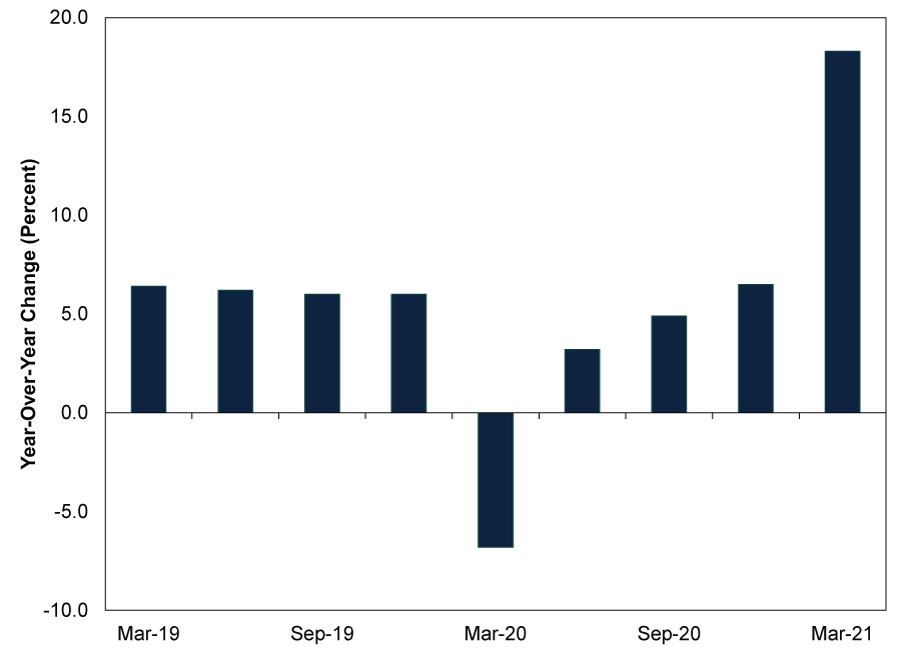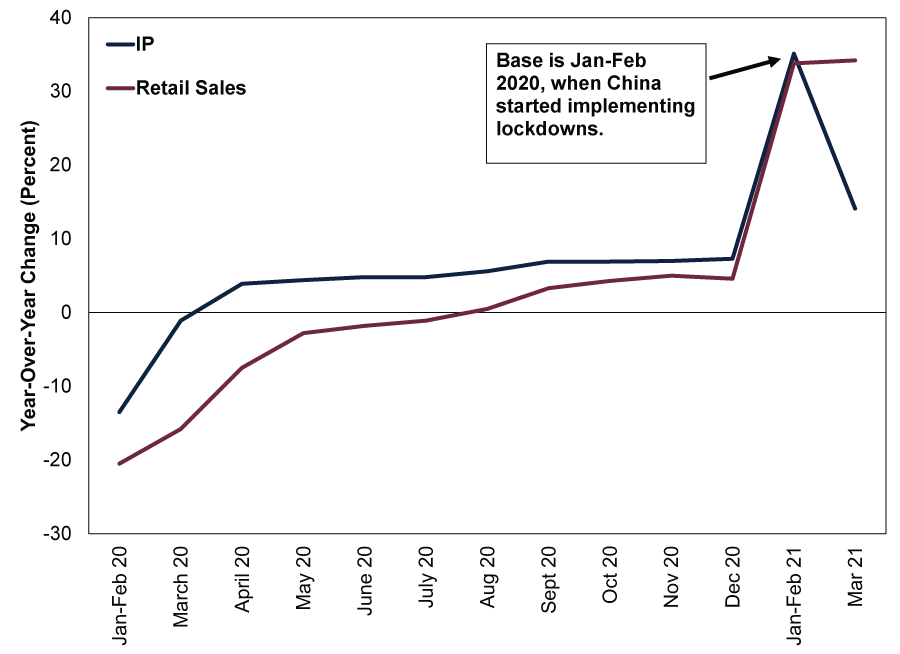Personal Wealth Management / Economics
Takeaways From China’s Historic Q1 Economic Data
What we think the latest Chinese economic data reveal about what likely lies ahead for the rest of the world.
Editors’ Note: MarketMinder doesn’t make individual security recommendations. Any reference to an individual publicly traded firm herein is included merely to illustrate a broader point.
China’s latest economic data dump received a lot of attention amongst financial publications we cover, especially its eye-popping Q1 GDP (gross domestic product, a government-produced measure of economic output) growth rate. We also noted many analysts anticipating China’s economic recovery would likely slow in the coming quarters—a return to its pre-COVID normal—which we think sounds about right and should be fine for equities. In our view, Chinese economic figures are a useful, albeit imperfect, preview of post-pandemic economic life in the UK and other developed nations—a helpful way for investors to set their expectations for other major economies’ data.
Chinese Q1 GDP soared 18.3% y/y, a bit slower than some economists’ expectations, but still the fastest growth rate since the country began reporting quarterly GDP in 1992.[i] (Exhibit 1)
Exhibit 1: Chinese GDP’s Historic Q1

Source: FactSet, as of 16/4/2021. Chinese GDP, year-over-year percentage change, quarterly, Q1 2019 – Q1 2021.
However, the historic reading primarily reflected last year’s events, not unprecedented economic output. We are referring to the base effect, which skews results when the year-over-year reference point has a large, temporary rise or fall. That reference point is the denominator in the year-over-year growth rate calculation (the percentage change between results in a given month or quarter and the same month or quarter a year prior). Since COVID lockdowns are about a year old, it is skewing data higher in a major way. Even if the numerator (the present) doesn’t change much, a sharply lower denominator (the year-ago results) will inflate the growth rate for a spell.
This affects readings most in Emerging Markets like China that report most economic data on a year-over-year basis. Because China started implementing lockdown measures in January 2020—about two months before most of the developed world—the base effect showed up there first. Industrial production jumped 35.1% y/y in January and February before slowing to 14.1% in March, whilst retail sales soared 33.8% y/y in January and February and sped to 34.2% in March.[ii] (China’s National Bureau of Statistics [NBS] combines January and February data to remove the base effect skew from the Lunar New Year’s variable timing.) We think these huge growth rates mostly reflect a depressed, smaller base due to China’s most severe COVID restrictions in place from late January to early March. (Exhibit 2)
Exhibit 2: The Base Effect’s Impact on Monthly Data

Source: National Bureau of Statistics, as of 16/4/2021.
We have seen many analysts acknowledge the base effect’s impact on the Q1 GDP reading, and looking ahead, they say growth is likely to slow in the coming quarters, continuing a longer-term trend. We saw some experts cite Q1 GDP’s seasonally adjusted 0.6% q/q rise, a pretty marked deceleration from Q4’s 3.2% q/q.[iii] Now, many experts don’t trust these data, arguing the NBS has kinks to work out with its seasonal adjustment methodology.[iv] However, the focus on recent slower growth is notable, in our view.
We agree Chinese economic growth is likely to slow in the coming quarters—policymakers have telegraphed as much. The government set expectations for slower growth at March’s National People’s Congress meeting, aiming for “above 6%” annual growth for 2021—a target with plenty of leeway. The government also reiterated its desire to contain financial risks and maintain financial stability. In recent years, that has meant tamping down on credit growth—and March data suggest this is happening.
Total social financing—a broad credit gauge that encompasses loans and funding to the private sector from state-owned lenders and outside the traditional banking system—slowed by a percentage point in March to 12.3% y/y from February’s 13.3%.[v] Whilst a high base effect from last year’s COVID relief measures played a role, our financial news coverage has found instances in which the government has told financial institutions, both big and small, to tap the brakes on credit growth and focus on stability.
In our view, this isn’t a negative development—nor does it mean growth in the world’s second-largest economy is about to halt. Rather, we think it signals a return to normal. According to our research, the Chinese government has long sought to get the country’s non-bank lenders in order whilst allowing greater financial liberalisation (i.e., allowing market forces to have a larger role in deciding winners and losers)—all whilst maintaining economic stability. This process has gone in fits and starts, and after a brief pandemic-related pause, policymakers appear to have reprioritised these efforts.
Consider a Chinese bad bank—i.e., a financial institution created to deal with big state-owned lenders’ non-performing loans and other loss-generating assets—we have seen in headlines recently. China Huarong Asset Management Co., whose former chairman was recently executed due to charges of bribery, failed to release 2020 financial statements in early April. Some ascribed the delay to a possible restructuring, prompting speculation the government could allow the state-backed institution to fail[vi]—the most consequential default in over 20 years, according to some observers.[vii] Financial regulators’ recent comments seem to have quieted those concerns for now, but in our view, this saga highlights the government’s emphasis on getting financial bloat under control, whether among private or state-owned lenders. This apparent return to the pre-pandemic priority of stabilising the financial system suggests to us that the broader economic recovery is well underway.
In our view, China provides a rough snapshot of what the Western world can expect the further we get from the worst of the pandemic. Now, most developed economies aren’t command economies, in which governments play a dominant role in directing activity. COVID experiences vary, too, as regions face unique outbreak challenges and difficulties with vaccine distribution. But as developed countries begin to reopen thanks to a combination of recovered immunity and vaccine immunity, we expect them to soon return to their pre-pandemic trends. As China is now showing, that likely means slower growth ahead after the initial reopening bounce—not an acceleration—another sign this bull market is likely more late-cycle than early-cycle, in our view.
H/T: Fisher Investments Research Analyst Austin Fraser
[i] Source: FactSet, as of 16/4/2021.
[ii] Source: National Bureau of Statistics, as of 16/4/2021.
[iii] Ibid.
[iv] “How Stable Is China’s Growth? Shedding Light on Sparse Data,” Hunter Clark, Jeff Dawson, and Maxim Pinkovskiy, The New York Federal Reserve, October 2020. https://www.newyorkfed.org/medialibrary/media/research/epr/2020/epr_2020_china-lights_clark.pdf
[v] Source: FactSet, as of 4/13/2021.
[vi] We guess that would make it a bad-bad bank? Or is that what one would call the new bad bank that takes over the old bad bank’s assets?
[vii] “Why China ‘Bad Bank’ Huarong’s Fall Is Big Bad News,” Rebecca Choong Wilkins, Bloomberg, 17/4/2021. https://www.washingtonpost.com/business/why-china-bad-bank-huarongs-fall-is-big-bad-news/2021/04/18/8cbc9ffe-a0a8-11eb-b314-2e993bd83e31_story.html
Get a weekly roundup of our market insights.
Sign up for our weekly e-mail newsletter.

See Our Investment Guides
The world of investing can seem like a giant maze. Fisher Investments UK has developed several informational and educational guides tackling a variety of investing topics.




